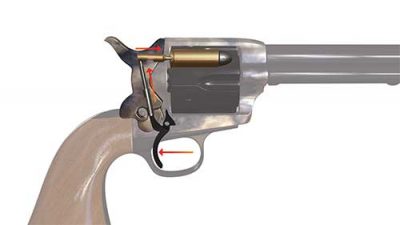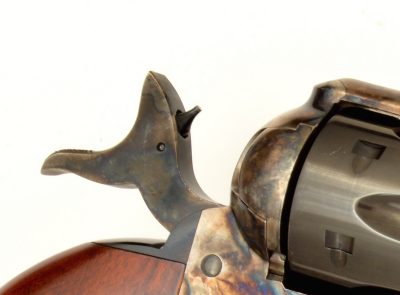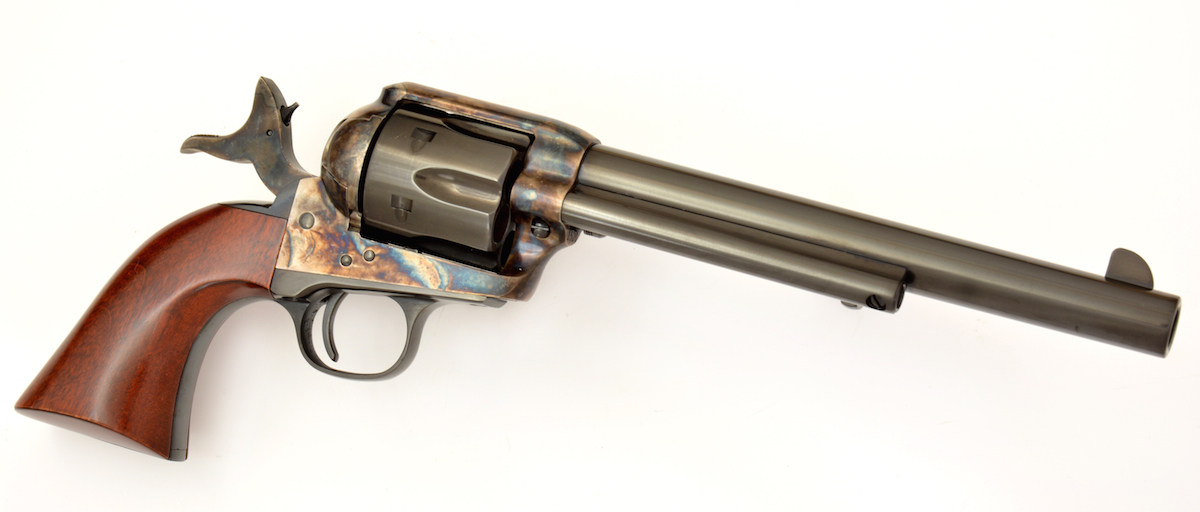
The Uberti Cattleman II is a revolutionary take on this classic design, featuring a retractable firing pin that allows the use of a full six rounds.

The new Uberti Cattleman II gives modern shooters a new take on a classic design. It is pictured in an El Paso Saddlery Tombstone Speed Rig shoulder holster based on the .c 1895 Al. Furstnow design. (Hat courtesy Golden Gate Western Wear)
In the latter days of the American West, shortly after the turn of the 20th century the Colt Model 1911 was fast becoming an option for lawmen and gunmen, as well as the U.S. military, which had adopted Colt’s new semiautomatic pistol as its standard-issue sidearm. There was, however, one early cautionary caveat; the 1911s were to be carried with an empty chamber in a flap holster, making them both slow to draw and slower still to get into action. This gave the “old reliable,” Colt’s legendary Peacemaker, an extended lease on life, even though military protocols also required carrying the Colt Single Actions with the hammer rested on an empty chamber.
There was a sense of elegance and simplicity to the Peacemaker’s original design. The mechanics were confined to only nine parts: mainspring, hammer swivel, hammer, short sear, short sear spring, long sear, lifter with spring (operates the lifter and long sear), trigger, and trigger spring. The remaining components of the SAA were cylinder pin and retaining screw, triggerguard and backstrap, hammer roller and hammer screw, hammer cam, hand (pawl), bolt, trigger, firing pin, and ejector assembly. The exterior bore three screws in the frame (one of which was the hammer screw), the retaining screw for the cylinder arbor, and the backstrap (2) and grip strap (1) screws. When one piece grips were replaced by two-piece grips, a grip screw was added to the parts list.
Between 1873 and the early 1900s the Colt’s Patent Fire-Arms Manufacturing Company had made literally dozens of improvements to the Peacemaker, including the most noteworthy change from the original Wm. Mason-designed “black powder” frame to the improved “smokeless powder” frame in 1892, which was symbolized by the new transverse cylinder latch replacing the original frame screw used to secure the cylinder pin. However, Colt’s did not formally pronounce the new models “safe for use with new smokeless powder cartridges” until 1900.
[one_third]
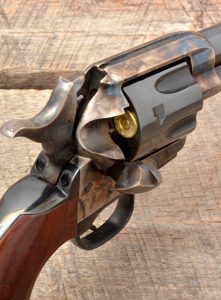
The Uberti Cattleman II with retractable firing pin has an authentic look when viewed from behind the hammer (shown at half cock).
[/one_third]
[two_third_last]

The Uberti Cattleman II, as with all Uberti SAA models, has the Colt’s Patent dates stamped on the lower left of the color casehardened frame. Also note the later transverse cylinder latch used on Colt SAA models produced after 1897.
[/two_third_last]
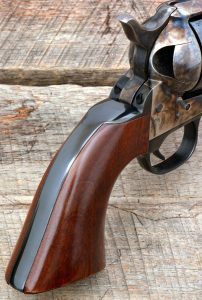
The Cattleman II is offered with color casehardened frame and brass triggerguard and backstrap or with blued steel triggerguard and backstrap as shown.
Prior to 1900 Colt stated that their revolvers were not designed for smokeless powder and in October 1898 this was a noted owner’s precaution. Beginning in 1900, Colt’s announced that their revolvers (serial number range beginning at approximately 192000) were guaranteed against smokeless powder. This had become necessary by the turn of the century, as the more powerful and cleaner-burning smokeless powder cartridges pretty much dominated the market.
Nearly all of the improvements Colt’s had made to the 1873 Single Action Army had been minor design alterations to cylinder flutes, front sights, ejector assemblies, hammers, grips, and choice of calibers. Nothing had ever been done to make the gun any safer to carry with the hammer resting on a loaded chamber. It was the nature of the beast, and a wise cowboy carried his Colt with only five chambers loaded unless he was getting ready for a fight or reloading in the middle of one. This is no doubt the origin of the cinematic cliché of the gunman opening the loading gate and checking his cylinder before a fight. In reality, it was a good time to add that sixth cartridge!
SPECS
Calibers: .45 Colt (tested), .44-40 WCF and .38/.357 Magnum
Barrel: 4¾ , 5½ and 7½ inches
OA Length: 10-13 inches
Weight: 35 ounces (average)
Grips: One-piece walnut
Sights: Fixed
Action: Single-action
Finish: Blued, case colored frame
Capacity: 6
MSRP: $549-$559
Making Changes
More than 140 years after the Colt SAA was invented, Uberti decided it was high time to change the rules and engineered a solution to the historic problem of having to “safely” carry a Single Action with the hammer resting on an empty chamber. And more to the point…since this has been done by other armsmakers for years using floating firing pins in the frame and transfer bars…to accomplish this feat without compromising the original Colt design by using a clumsy hammer safety or transfer bar to impinge on the otherwise classic lines of the original Colt hammer, firing pin or frame. For a proper Colt Single Action Army design you can’t have a hammer safety or transfer bar, thus for Colt the old empty chamber rule, like the gun itself, has pretty much survived for more than 140 years.
[one_half]
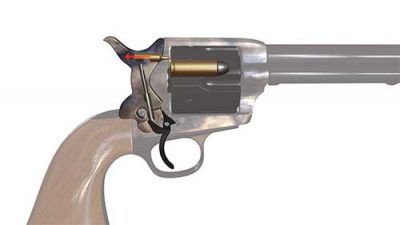
The Cattleman II’s internal safety mechanism disengages the firing pin when the gun is not cocked, thus allowing it to float free in the hammer. Cutaway images courtesy of Uberti.
[/one_half]
[one_half_last]

As the illustration shows, the firing pin can only extend and strike a chambered round when the hammer is cocked.
[/one_half_last]
The designers at A. Uberti (one of Italy’s oldest and most fabled makers of western handguns and rifles, which was founded by its namesake, Aldo Uberti, in the 1950s), have developed an internal hammer mechanism that works with a retractable firing pin floating free within an internal guide. When the hammer is not cocked the firing pin floats inside the head of the hammer and cannot exert any forward pressure on a chambered round. In order for that to happen, the hammer must first be cocked, and only then will the sear that engages the firing pin allow it to lock in the forward position. As soon as the gun is fired, or the hammer is lowered, the firing pin floats free again. Think of it as a Glock trigger safety inside of a revolver’s hammer. The best part is that from the outside the retractable firing pin allows the hammer and frame to look exactly as they should (and did back in the day), allowing this new line of Uberti Single Actions to look exactly like their historical predecessors.
On Target
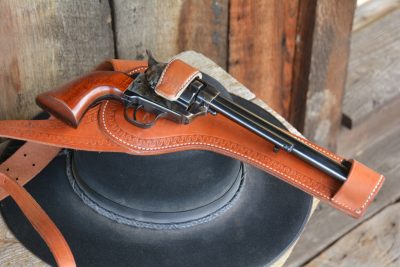
Shoulder holsters were becoming very popular by the late 1880s. Just before the turn of the century, Miles City, Montana holster maker Al. Furstnow developed his famous “Sheriff’s Lightning Spring Shoulder Holster,” which became the first “skeletonized” shoulder holster design. (Holster by El Paso Saddlery)
Uberti offers its new Cattleman II with retractable firing pin chambered in .45 Colt, .44-40 WCF and .38/.357 Magnum with a choice of 7-1/2 inch, 5-1/2 inch or 4-3/4 inch barrel lengths. The guns feature a case colored frame and hammer, and choice of a brass triggerguard and backstrap for $549; or with case colored frame and blued steel triggerguard and backstrap for $559. Matched sets of Cattlemen II Steel, in .45 Colt or .38/.357 Magnum, are also available for $1,159.
The 7-1/2 inch model tested proved to be a well-balanced gun with standard-sized Single Action grips, and weighing in at 39.5 ounces (unloaded). The finish was highly polished for a good, deep blue gloss and the chemical case colors on the frame and hammer were rich in shades of blue and gray with hints of red.
One of the characteristics that often separate Colt Single Actions from Italian reproductions is the sound and feel of the hammer. A Colt hammer has a distinctive and audible four clicks as it is thumbed back. The Uberti, while comparatively smooth for a standard (un-tuned) action, has only three steps and a resistance of 7 pounds, 11.5 ounces, Colt actions average 7 pounds 2.5 ounces, so overall hammer draw on the Uberti is very close in feel if not sound. Trigger pull on the Uberti Cattleman II averaged a light and very crisp 3 pounds, 9.4 ounces.
[one_half]
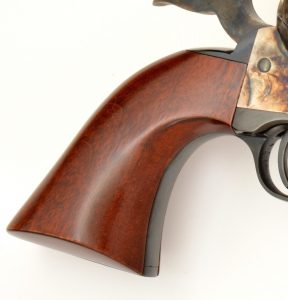
The Cattleman II comes with attractive Walnut grips. The author tested the version with the steel grip frame.
[/one_half]
[one_half_last]
[/one_half_last]
The result is an attractive and appealing revolver for Old West enthusiasts who want a classic-style gun that they can actually shoot. From its deep blued cylinder to its case colored frame to its attractive Walnut grips, this Uberti Cattleman II is a truly appealing gun. Add in the new firing pin safety mechanism that takes a retro classic design and brings it into the 21st century, and you have a gun that offers a lot to the modern-day shooter.
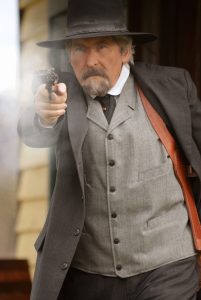
The Uberti Cattleman II has the heft, feel, and action of a smokeless powder frame Colt Single Action and proved to be just as fast to handle and just as accurate.
For the range test, shot at 15 yards (45 feet), aiming at a 20×16 inch cardboard target and firing one handed, gunfighter style, the ammo choices were divided between Ten-X .45 Colt 200 gr. RNFP, Goex Black Dawge 235 gr. RNFP black powder, and new Freedom Munitions’ Leadville 200-grain RNFP. Ten-X always has modest recoil and traveled down range at 621fps average. Black Dawge, the smokiest black powder cartridge around and guaranteed to provide a loud bark and commensurate kick, clocked a muzzle lifting 850 fps average, and the new Leadville, with the mildest recoil of all three .45 LC rounds, sauntered downrange at 601 fps average. With no appreciable recoil from the 7-1/2 inch Uberti SA, Leadville punched five rounds into the target at 1.5 inches with two overlapping pairs, Ten-X offered up its usual get-the-job-done accuracy with five clustering around a 2-inch circumference, and Goex slammed five into 2.18 inches with an overlapping pair. Shooting accuracy with Uberti Single Actions is always pretty good and the new Cattleman II was right up to snuff with these cowboy loads hitting the target just about point of aim from 45 feet. Bottom line, you can take this gun right out of the box and shoot a competition match. Might not be a fast as a tuned action (which one can always get done), but for $550 retail (and who pays retail?) this is one of the best Single Actions Uberti has ever built, and also one of the most authentic.

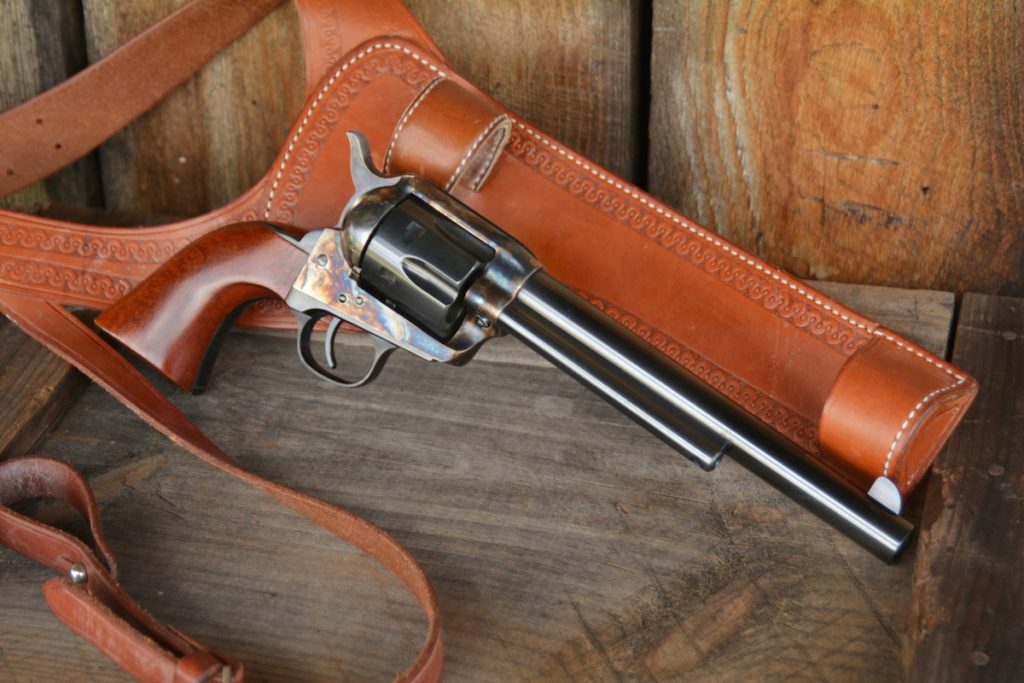
Uberti has been manufacturing superb Single Actions for decades and with the latest Cattleman II offers up a model that is not only accurate on the outside, but accurate in detail when you cock the hammer.
For more information visit https://www.uberti.com/.
To purchase a Uberti Cattleman II on GunsAmerica.com, click this link: https://www.gunsamerica.com/Search.aspx?T=cattleman%20II
